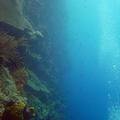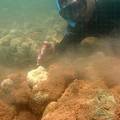 夏威夷與澳洲科學家的最新研究發現,侵擾陸地生態系將連帶破壞下游的珊瑚礁。濫伐林場、農耕與開發所造成的土壤侵蝕沖刷,會使珊瑚死亡。因此科學家強調,要保育珊瑚礁,除了避免過度漁撈,也應同時注重上游的土地管理。
夏威夷與澳洲科學家的最新研究發現,侵擾陸地生態系將連帶破壞下游的珊瑚礁。濫伐林場、農耕與開發所造成的土壤侵蝕沖刷,會使珊瑚死亡。因此科學家強調,要保育珊瑚礁,除了避免過度漁撈,也應同時注重上游的土地管理。
研究人員花費6年時間,在密克羅尼西亞的帛琉、關島與波納佩3個島嶼,調查流域與出海口珊瑚礁的關係。研究員之一,同時也是密克羅尼西亞保育基金會主席柯斯特卡(Willy Kostka)表示,「珊瑚礁的永續生存,取決於我們如何妥善管理從山區至海洋人類所造成的衝擊。」
周圍陸地活動帶來的沖刷沉積物,不但是珊瑚礁最大的威脅,也會影響休漁區等其他海洋保育工作。河川沖刷將泥土帶進海洋,堆積在珊瑚礁四周,若藻類生長過快,會在泥土之上成層覆蓋,阻擋珊瑚幼蟲附著。當藻食性魚類因過度漁撈而消失,藻類生長將無法得到控制,珊瑚便「窒息」死亡。
研究中3個太平洋島嶼的居民已採取行動,將山區至海底的所有生態系都納入管理,以幫助珊瑚礁復原。居民將作物由高地雨林移至平地,復育河川流域植被以控制土壤侵蝕,並停止砍伐紅樹林,建立從河流源頭連通到珊瑚礁的保護區。另外,其中一個社區正同時考慮暫停捕撈藻食性魚類。
 以關島的研究點佛哈灣(Fouha Bay)為例,海灣周圍的山脈地勢陡峭,而獵人時常燒火清理植被以捕捉野鹿野豬,土壤侵蝕速度因此加快,海灣沉積物大增造成珊瑚死亡。比較海灣南側2003年與1978年的觀測資料,可發現珊瑚種類與面積都隨河川排放量明顯衰減。
以關島的研究點佛哈灣(Fouha Bay)為例,海灣周圍的山脈地勢陡峭,而獵人時常燒火清理植被以捕捉野鹿野豬,土壤侵蝕速度因此加快,海灣沉積物大增造成珊瑚死亡。比較海灣南側2003年與1978年的觀測資料,可發現珊瑚種類與面積都隨河川排放量明顯衰減。
研究結論認為,珊瑚礁與其他沿岸海洋生態系延伸至鄰近流域之內,建議應視為整體予以管理。身為首席科學家的夏威夷大學李察曼(Robert Richmond)博士說:「全世界的珊瑚都在消失中,太平洋島嶼正示範如何以先進科學配合傳統知識扭轉這個趨勢。」
Coral reefs suffer when the lands above them are disturbed, finds new research by scientists from Hawaii to Australia. Clearcut logging, farming and development lead to erosion and runoff that kills corals, making it just as important to manage the land above reefs as it is to protect them from overfishing, the scientists confirmed.
Over six years, the researchers studied the connection between watersheds and adjacent coral reefs on three Micronesian islands - Palau, Guam and Pohnpei. "It is clear that sustaining our coral reefs depends on how well we manage human impacts from the mountains to the sea," said Willy Kostka, a co-author of the study and director of the Micronesia Conservation Trust.
Sedimentation and runoff from activities on land are among the biggest threats to nearby reefs and are interfering with other marine conservation efforts, such as no fishing zones. River runoff sends mud into the ocean, where it is compacted around reefs. Algae can outgrow corals to form a mat that traps the mud and prevents coral recruitment. When overfishing occurs, removal of plant-eating fish means algae growth can no longer be controlled, and the reefs are suffocated.
Actions taken by the three Pacific island communities to restore reef health focused on managing entire ecosystems from hilltop to sea floor.Communities relocated crops from upland rainforests to lowland areas, restored vegetation in watershed areas to control erosion, halted the clearing of mangroves, and established a continuous protected area from the top of the watershed to the reef. One community is also considering a temporary ban on catches of plant-eating fish.
Fouha Bay, the study site in Guam, is surrounded by steep hills that deer and pig hunters often burn to clear vegetation, which accelerates erosion rates. The bay has high levels of sedimentation that are suffocating the reefs.Data taken along the southern side of the bay in 1978 and again in 2003 showed a clear loss of coral species and coral cover over time that appears to be due to watershed discharges.
The study's conclusion that coral reefs and other coastal marine ecosystems extend into adjacent watersheds leads the authors to the recommendation that they should be managed as an integrated unit."Reefs are in decline worldwide," said lead author Dr. Robert Richmond of the University of Hawaii's Kewalo Marine Laboratory in Honolulu, "and the Pacific islands of Micronesia are showing us how modern science and traditional knowledge can be combined to reverse that trend.
全文及圖片詳見ENS



